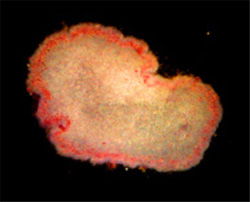
Sponges Squeezed Out of First Place
Evolutionists are having a difficult time deciding which animal supposedly came first: the sea sponge, comb jellies, or placozoans (the simplest multicellular animals).
Last year many evolutionists essentially declared: “Move aside, sponges. Comb jellies are now the world’s oldest animal.” This year, other researchers placed placozoans at the base of the tree of animals. After a “total evidence analysis” of genes and body forms, the researchers assumed that the “simpler organisms,” placozoans, evolved first.

New studies shed light on Trichoplax adhaerens, the only living example of multicellular animals called placozoans. Photo: Wolfgang Jakob
In reality, the researchers left out the most important evidence—the Bible. God created all these different kinds of creatures separately, in the very beginning. They never had a common ancestor, and any similarities indicate something about their common Designer.
When we look at these amazing creatures, we discover that both placozoans and sponges have genes like those for a nervous system, yet they don’t possess a nervous system. Each of them is a unique creature—with a hodge-podge of well-designed parts combined in a way unlike those in any other creatures.
Contrary to claims that placozoans appear simple, they demonstrate remarkable complexity and a unique design to fulfill their Creator’s purpose.
* B. Schierwater, M. Eitel, W. Jakob, H. J. Osigus, H. Hadrys et al., “Concatenated Analysis Sheds Light on Early Metazoan Evolution and Fuels a Modern ‘Urmetazoon’ Hypothesis,” PLoS Biology 7(1): e20, 2009.
Answers Magazine
July – September 2009
How do I deal with cancer? Why did God allow evil in the world? Why do snakes appear designed to kill? God’s curse is a historical reality, and we can see its results in everyday life. Don’t miss this special issue, which will give you the tools to tackle questions about evil and its true origin.
Browse Issue SubscribeRecommended Resources

Answers in Genesis is an apologetics ministry, dedicated to helping Christians defend their faith and proclaim the good news of Jesus Christ.
- Customer Service 800.778.3390
- © 2025 Answers in Genesis





